It's all about the classical music composers and their works from the last 400 years and much more about music. Hier erfahren Sie alles über die klassischen Komponisten und ihre Meisterwerke der letzten vierhundert Jahre und vieles mehr über Klassische Musik.
Total Pageviews
Wednesday, September 21, 2022
Famous Music Composers New York
by Hermione Lai, Interlude
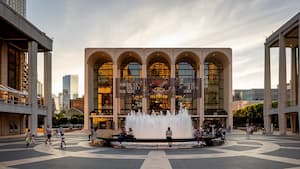
Lincoln Center
In 1944, Leonard Bernstein wrote music for the musical On the Town. It tells the story of three sailors on shore leave for their 24 hours of adventures and romance in New York City. The song “New York, New York,” with lyrics by Betty Comden and Adolph Green features the well-known line:
New York, New York, a helluva town
The Bronx is up but Battery’s down.
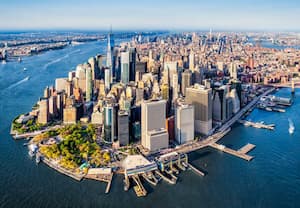
New York City
For the 1949 MGM film the word “helluva” was changed to “wonderful” to protect delicate sensibilities. I’ve been to New York a couple of times, and it is still a helluva town. There is around the clock excitement including Broadway shows, museums, historical attractions, and some of the best restaurants on the planet. And for every lover of classical music, there is no better place to visit than Lincoln Center to catch the NY Philharmonic, the Metropolitan Opera, the New York City Ballet, the Juilliard School of Music; in all 11 resident arts organizations presenting music, theater, dance, film, opera and artists from across the globe. Did I already mention Carnegie hall? The city of New York was, and still is, home to countless famous music composers, so I decided to write a blog on celebrated composers either born in New York or famously active in that city.
Leonard Bernstein
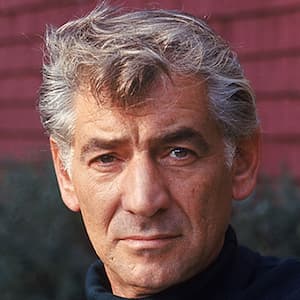
Leonard Bernstein
Talking about Leonard Bernstein, although he was born in Massachusetts, he made NYC his permanent home. He lived in various apartments in Manhattan, and as the first American-born conductor of a major American symphony orchestra, he led the New York Philharmonic to world fame. It is no surprise that his most popular musical for Broadway, West Side Story, is set in the Upper West Side of Manhattan in New York City.
George Frederick Bristow
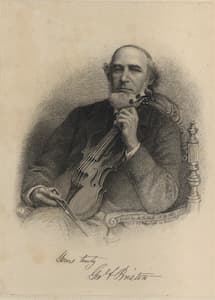
George Frederick Bristow
Leonard Bernstein is considered “one of the most prodigiously talented and successful musicians in American history,” but famous music composers of New York can be traced back to the middle of the 19th century. George Frederick Bristow was born in the New York borough of Brooklyn on 19 December 1825. Musically precocious, he started his professional career as a violinist at the age of 13 and played first violin with the New York Philharmonic SO from 1843 to 1879. Bristow was also active as a conductor, and he led the New York Harmonic Society (1851–63) and the Mendelssohn Society (1867–71) in performances of large choral and orchestral works. I read that Bristow attempted to establish a “native style in American art music.” As such, we frequently find American titles or textual content in his compositions, for example, “Rip Van Winkle” “The Great Republic” “Columbus” and “The Pioneer.” Nationalist titles aside, scholars write “his music was typically European in style, reminiscent of the music of Mendelssohn.” In all, Bristow appears to have written 135 compositions, and on the strength of this output alone, he should certainly be considered one of the famous music composers of New York.
George Gershwin
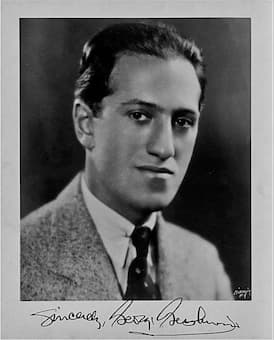
George Gershwin, 1935
The best-known and most famous music composer of New York is undoubtedly George Gershwin. Born in Brooklyn, he grew up on New York’s Lower East Side, and at the age of 15, he already worked for the Tin Pan Alley music-publishing firm of Jerome H. Remick & Company as a song plugger. Basically, that means he was engaged as a salesman to promote the firm’s songs by playing and singing them for performers. In 1918 he signed a contract with Thomas B. Harms Music Publishing Company, a firm that eventually published over 90 percent of all Broadway songs. Gershwin lived the American dream, and since he composed sometimes up to 6 songs a day, he made a financial killing. “For the longest time,” as he later wrote in life “I wanted to work at big compositions” and within a couple of years, he developed from a songwriter into a composer. Gershwin “primarily synthesized and utilized elements of many styles, including the music of New York’s Yiddish theatre, vaudeville, ragtime, operetta, jazz, Tin Pan Alley and Broadway songs, the music of the Gullah people and the impressionist and post-Romantic music of European composers.” Intimately connected with New York City, his Rhapsody in Blue and the Concerto in F “ brought jazz music into the concert hall.”
John Zorn
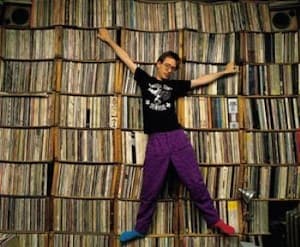
John Zorn
The metaphor of calling New York City a melting pot dates from the beginning of the 20th century. Then as now, it is home to a unique diversity of people, and over 800 languages are spoken throughout its 5 boroughs. That kind of diversity is expressed in glorious food, areas of different religions and cultures, and music. Currently, a Manhattan-based scene that is sometimes called “New Music” has emerged. As a contemporary musical stream, its composers are strongly influenced by minimalism and the various musical styles of the community. John Zorn, born in New York City, writes about his compositions. “All the various styles are organically connected to one another. I’m an additive person—the entire storehouse of my knowledge informs everything I do. People are so obsessed with the surface that they can’t see the connections, but they are there.” Reminiscent of Gershwin’s eclecticism, Zorn uses avant-garde and experimental approaches to composition and improvisation, “inclusive of jazz, rock, hardcore, classical, contemporary, surf, metal, soundtrack, ambient, and world music.” Zorn explains, “I write in moments, in disparate sound blocks, so I find it convenient to store these events on filing cards so they can be sorted and ordered with minimum effort. Pacing is essential. If you move too fast, people tend to stop hearing the individual moments as complete in themselves and more as elements of a sort of cloud effect… I worked 10 to 12 hours a day for a week, just orchestrating these file cards.” Critics have called Zorn “one of the most influential musicians of our time,” and he is certainly one of the famous contemporary music composers of New York.
Edward MacDowell
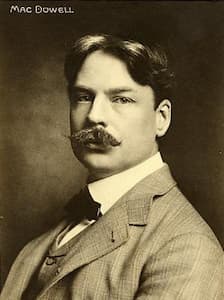
Edward MacDowell
Although he spent the majority of his professional life in Boston, Edward MacDowell was born in New York City. Coming from a Quaker background, young Edward showed great talent for drawing and music at an early age, and he started piano and violin lessons at the age of 8. Destined for greatness, his mother took him to Paris to attend the Conservatoire, but he soon left for Germany to study composition with Joachim Raff. We also know that he played for Franz Liszt at conservatory concerts, and that the great virtuosos recommended some early MacDowell compositions for publication by Breitkopf & Härtel. Returning to the United States, MacDowell and his wife lived in Boston from 1888 to 1896, from then on in New York until his death in 1908. MacDowell described “music as a language, but a language of the intangible, a kind of soul language.” While the romantic tradition in music never lost its relevance and importance, MacDowell eventually began using elements of American folk music in his compositions, and “his two piano concertos are described as the “most important works in the genre by an American composer other than Gershwin. His first piano concerto premiered in New York in 1888, and he returned the following year to premiere his second.
William Schuman
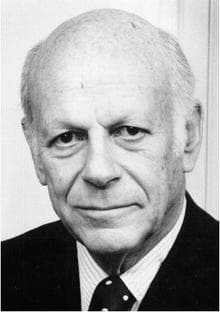
William Schuman
When it comes to performing arts education, the Juilliard School in New York City is considered one of the best drama, music, and dance schools in the world. Founded by Frank Damrosch, the godson of Franz Liszt in 1905, the conservatory quickly convinced American musicians that they did not need to go abroad for advanced study. In 1945, composer William Schuman expanded the school’s curriculum by establishing a Dance Division under the direction of Martha Hill and he also established the Juilliard String Quartet “alongside a groundbreaking music theory curriculum.” Schuman was born in Manhattan and later enrolled at New York University to pursue a business degree. He already dabbled in composition when on 13 April 1930 he attended a Carnegie Hall concert of the New York Philharmonic, conducted by Arturo Toscanini. Schuman later said of that experience, “I was astounded at seeing the sea of stringed instruments, and everybody bowing together. The visual thing alone was astonishing. But the sound! I was overwhelmed. I had never heard anything like it. The very next day, I decided to become a composer.” While Schuman’s recollections of events might not have been entirely accurate, he did become one of the famous music composers of New York. Schuman won the inaugural Pulitzer Prize for Music in 1943 for his Cantata No. 2 “A Free Song,” and conductor Leonard Slatkin wrote, “Schuman is the man who may eventually emerge as the great American symphonist.
Marion Bauer
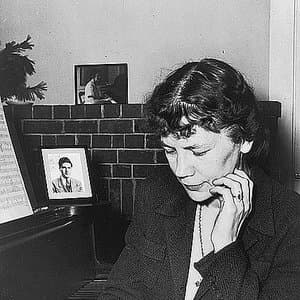
Marion Bauer
Marion Eugénie Bauer was born in Washington, but showing an early aptitude for music, she moved to New York City to focus on a career in composition. She met the pianist Raoul Pugno, and he invited Bauer to study with him in Paris in 1906. In turn, Bauer became the first American to study with Nadia Boulanger. For the next decade Bauer moved between New York City and Europe, but in September 1926 she was hired as instructor, and later professor, at the New York University music department, becoming the first female music faculty. She taught classes in composition, form and analysis, aesthetics and criticism, and music history and appreciation. As a composer, Bauer wrote for piano, chamber ensemble, symphonic orchestra, solo voice, and vocal ensembles. Always an advocate of contemporary music, her own compositional voice is considered relatively conservative, featuring plenty of impressionistic and romantic influences in her works. Following a concert exclusively devoted to her music in New York Town Hall in 1951, a critic writes, “The music is prevailingly contrapuntal, and dissonance is not absent. Yet the fundamental concept is melodic, the thinking clear and logical, the sentiment sincere and direct.”
John Corigliano
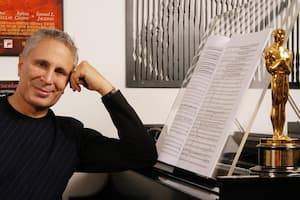
John Corigliano
John Corigliano was born in New York City in 1938, son of John Corigliano Sr., the concertmaster of the New York Philharmonic for 23 years. He studied at Columbia University, worked as a music programmer and music director for New York City radio stations, and worked as an assistant to the producer on the Leonard Bernstein “Young People’s Concert.” Corigliano achieved international recognition by winning the chamber-music competition of the Spoleto Festival in Italy with a Sonata for Violin and Piano. He soon collaborated with mainstream musicians and institutions, and “his oft-stated commitment to intelligibility and his mostly tonal early works have sometimes obscured the extent of his technical range and his often daunting progressivism.” To be sure, Corigliano is an eclectic composer who is not afraid to use many styles in his writing. “He is also a colorist,” according to a conductor, “as he is able to use whatever instruments and vocal forces he has at hand to create new sound worlds.” He has won a Pulitzer, an Oscar and five Grammys, and he explains “When I was writing my early pieces, I did it in a hyper way because for me, composing was such a nerve-racking thing to do. Now, the whole note is my friend; an adagio is what I look for.”
Elliott Carter
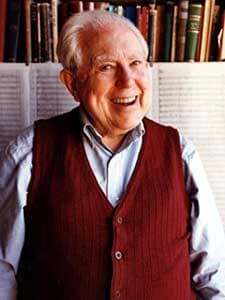
Elliott Carter
Elliott Carter, born in New York City, is one of the most famous music composers of the second half of the 20th century. His compositions are performed throughout the world, as his musical language combines elements of European modernism and “American ultra-modernism in a distinctive style of surging rhythmic vitality, intense dramatic contrast, and innovative facture.” He studied at Harvard and subsequently with Nadia Boulanger, and upon his return to the United States, he settled in New York. In his Cello Sonata, Carter was looking to “re-examine all aspects of music in order to achieve an emancipated musical discourse, in which a new rhythmic texture brought with it a harmonic language, establishing a new emotional intensity and breadth, and giving his music an epic quality.” Carter held teaching positions at the Peabody Conservatory (1946–8), Columbia University (1948–50), Queens College, CUNY (1955–6), Yale University (1960–62), MIT, and Cornell University (from 1967). His one long-term teaching position was at the Juilliard School (1964–84). His numerous honors include two Pulitzer Prizes (1960, 1973), the Sibelius Medal (1961), the Gold Medal of the National Institute for Arts and Letters (1971), the Ernst von Siemens Prize (1985), the National Medal of the Arts (1985), the Gold Medal of the Royal Philharmonic Society (1996), the Prince Rainier Foundation Music Award (1998), and induction into the Classical Music Hall of Fame (1998).
Aaron Copland

Aaron Copland, 1933
In this little blog, it is of course impossible to describe in detail the countless famous music composers of New York, but I might at least mention William Fry, Charles Griffes, Leo Ornstein, Rubin Goldmark, Rogger Sessions, Gunther Schuller, Leon Kirchner, Bernard Herrmann, Meredith Monk, Laurie Anderson and a whole crop of young and exciting composers either born or calling New York home. It might be fitting to close with the “Dean of American Composers” Aaron Copland, born in the borough of Brooklyn on 14 November 1900. One of America’s greatest contemporary composers, he was able to capture the American experience with works that have an immediate appeal. As he wrote, “I no longer feel the need of seeking out conscious Americanism. Because we live here and work here, we can be certain that when our music is mature it will also be American in quality.” Copland had long felt an increasing dissatisfaction with the relations between the music-loving public and the living composer. He wrote, “It seemed to me that we composers were in danger of working in a vacuum.” He quickly realized that the radio, phonographs, and film scores were actually creating contemporary music. “It made no sense to ignore them and to continue writing as if they did not exist. It was worth the effort to see if I couldn’t say what I had to say in the simplest possible terms.” To me, Aaron Copland is simply a legend, and certainly one of the most famous music composers of New York.
WER IM ORCHESTER DEN TON ANGIBT
Warum hauen nur Männer auf die Pauke?
Auch im Konzertsaal herrscht noch keine Geschlechtergerechtigkeit.
Von: VOLKER WEINL, Bild
In deutschen Orchestern geben meistens Männer den Ton an. Das ergab eine Befragung des Deutschen Musikinformationszentrums unter 129 Berufsorchestern in Deutschland.
Insgesamt wirken 60 Prozent Männer und 40 Prozent Frauen zwar halbwegs ausgeglichen. Weniger harmonisch wirkt das Geschlechterverhältnis, wenn man sich die in der Rangordnung am höchsten stehenden und am besten bezahlten Positionen anschaut: Bei den sogenannten Stimmführern und Solisten (Zuschlag bis zu 876,70 Euro) beträgt der Männeranteil 74 Prozent. Auch eindrucksvoll: Frauen spielen zwar 61 Prozent aller Violinen. Der Konzertmeister aber – die wichtigste Geige im Orchester – ist in 70 Prozent der Fälle männlich. Nur den Konzertmeister begrüßt der Dirigent per Handschlag.
Frauen sind auf dem Vormarsch, heißt es. So passt es ins Bild, wenn das Statistische Bundesamt aktuell mitteilt
Und der Dirigent? Ist praktisch immer ein Mann! „Aktuell gibt es in 129 Orchestern nur drei Chefdirigentinnen“, sagt Anke Steinbeck (42) vom Deutschen Musikrat. „Im Orchesterbetrieb gilt leider noch immer: Wo Macht, Renommee und Geld zusammenkommen, dominieren die Männer.“
Orchester-Musikerinnen waren früher die Ausnahme
Auch am Klischee von typisch männlich und typisch weiblichen Instrumenten ist was dran. Pauke: 95 Prozent Männer. Harfe: 94 Prozent Frauen. Warum? Die Gründe sind vor allem historisch. „Anfang der 1960er-Jahre waren Frauen in professionellen Orchestern noch die absolute Ausnahme“, sagt Gerald Mertens (63) von der Deutschen Orchestervereinigung. „Waren überhaupt Frauen dabei, spielten sie vorrangig Harfe.“ Bei den Berliner Philharmonikern gab es noch bis 1982 ausschließlich Männer.
Die wichtigsten Orchester-Instrumente – und wer sie spielt:
98 Prozent beträgt der Männer-Anteil bei der TUBA
97 Prozent der Musiker mit POSAUNE sind Männer
95 Prozent der Orchester-PAUKISTEN sind Männer
94 Prozent beträgt der Frauen-Anteil bei der HARFE
85 Prozent ist die Männerquote beim KONTRABASS
66 Prozent der VIOLINISTEN sind Frauen.
An den körperlichen Voraussetzungen liegt es nicht, dass Frauen selten „Männerinstrumente“ wie Tuba, Posaune oder Kontrabass spielen. Mertens: „Es kann einfach Jahrzehnte dauern, bis sich Rollenmodelle ändern. Unterrichtet aber an einer Musikschule endlich eine Kontrabassistin, wirkt diese dann auch als Vorbild für junge Mädchen.“
Doch Mertens glaubt an eine weiblichere Orchester-Zukunft: „Junge Mädchen und Frauen legen im Vergleich zu jungen Männern offenbar eine höhere Übe-Disziplin an den Tag. Daher vermuten wir, dass sie in nicht allzu ferner Zeit auch verstärkt Solopositionen besetzen werden.“
.jpg)